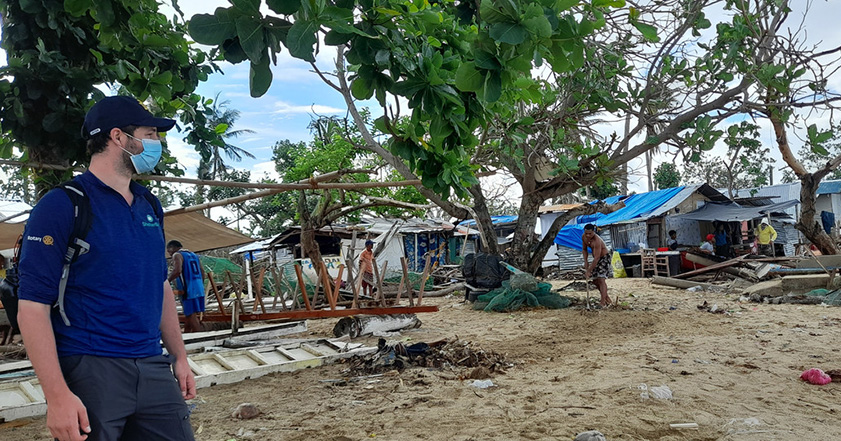Press release – 28 February 2022
A man from south London has been helping the relief effort in the Philippines after millions of people were left homeless in the wake of a super typhoon that devastated the country. More than two months after Typhoon Rai tore across the islands tens of thousands of people are still without adequate shelter.
Henry Thompson from Battersea is in the Philippines on his first deployment for the international disaster relief charity, ShelterBox. The charity provides emergency shelter and other essential items to families across the world who have lost their homes to disaster and conflict.
The Philippines is ravaged so frequently by severe storms that ShelterBox has aid pre-positioned and a four-person team permanently based in the country. It means the charity, which has responded to the Philippines more than 30 times since it was founded in 2000, can respond more quickly when disaster strikes.
Henry, a programme manager for ShelterBox, says: “This work that is going on behind the scenes in ‘peace-time’ is so crucial for when we do come to respond. Having that understanding of the local government systems, the local languages, the culture, just means that we can hit the ground running.”
ShelterBox was one of the first charities to start distributing aid following the typhoon and Henry is part of a small team from the UK that has been deployed to help ShelterBox Operations Philippines support communities most affected by the typhoon.
He says: “Our colleagues in the Philippines describe it as the worst storm they have experienced in this particular region and were shocked by just how long it went on for. However, even before it was over, they were planning and working on the response, knowing that ShelterBox aid would be needed – really going above and beyond to help their fellow Filipinos.”
ShelterBox hopes to provide shelter aid to around 100,000 people. The charity has been distributing aid including corrugated iron sheets, hurricane strapping, tarpaulin, rope, tools, solar lights and mosquito nets to island communities who are finding it most difficult to access essential resources to build shelter.
Henry says: “The solar light is critical for some of these families as electricity is still not restored in some parts of the Philippines and isn’t set to be for some time.
“When you unfold the tarpaulin during the demonstrations, people are truly excited to receive something that will keep them and their families warm, dry and together. We have also heard from mothers who can now ensure their children sleep safe at night, protected from dengue fever, which has had high prevalence in this region.”
ShelterBox, together with local Rotary clubs and partners Humanity and Inclusion, has already helped shelter thousands of families in southern Cebu and is now working in Bohol to help thousands more people rebuild.
Henry says: “In Cebu city, power and telecoms lines were down, roofs were still off buildings. However, it was only when we moved over to Bohol, that we saw the true force of the typhoon in the more rural, coastal, and island communities.
“In many of the municipalities we are serving, up to 80% of homes have been totally destroyed. While clear up operations have been underway since the typhoon struck, the sheer scale of devastation is still clear.
“Despite the damage to their homes, people have started to salvage any materials that they can and have constructed very crude shelters. These provide little protection from the elements so the tarpaulins in our packages will have a huge impact on their lives.”
ShelterBox is one of the first NGOs to get to Bohol and there are many areas which still have not been reached. Robust local partnerships with Rotary and Humanity and Inclusion have made this possible, providing logistical support to get items to the hardest to reach locations and helping with distributions.
Henry says: “Naturally, the need is so great, and the resources are finite so we cannot reach everyone and that is difficult. The most striking thing for me is to see the strength and resilience of the affected communities, the volunteers, the local government and our partners. Despite everything that has happened, the sense of community here is infectious with everyone chipping in to support their neighbours.
“These are people who, despite surviving the typhoon themselves and having to continue with their own lives and rebuilding, commit their time to supporting their community’s recovery. At every distribution, the real manpower behind it all comes from the communities themselves – with people manning registrations desks, supporting with crowd control, and moving the aid items.”
Having aid already positioned in a warehouse in the Philippines has allowed ShelterBox to scale up its response to meet the needs of people more quickly.
“Logistics is one of the things that takes the longest in responses,” says Henry. Having stock to reach over 10,000 families on hand meant that as soon as we could identify beneficiaries, we could start distributing immediately.
“This response has completely drained our stocks in the Philippines so we are desperate to fill the warehouse up again so that when the next disaster strikes, ShelterBox is ready to respond. We can only do that with the incredible help of our supporters and donors.”
To find out more about ShelterBox and its response in the Philippines visit shelterbox.org.

